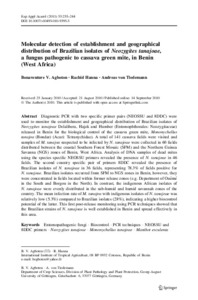| dc.contributor.author | Agboton, B. |
| dc.contributor.author | Hanna, R. |
| dc.contributor.author | Tiedemann, A. von |
| dc.date.accessioned | 2019-12-04T11:07:58Z |
| dc.date.available | 2019-12-04T11:07:58Z |
| dc.date.issued | 2011 |
| dc.identifier.citation | Agboton, B., Hanna, R. & von Tiedemann, A. (2011). Molecular detection of establishment and geographical distribution of Brazilian isolates of Neozygites tanajoae, a fungus pathogenic to cassava green mite, in Benin (West Africa). Experimental and Applied Acarology, 53(3), 235-244. |
| dc.identifier.issn | 0168-8162 |
| dc.identifier.uri | https://hdl.handle.net/20.500.12478/1675 |
| dc.description | Article purchased |
| dc.description.abstract | Diagnostic PCR with two specific primer pairs (NEOSSU and 8DDC) were used to monitor the establishment and geographical distribution of Brazilian isolates of Neozygites tanajoae Delalibera, Hajek and Humber (Entomophthorales: Neozygitaceae) released in Benin for the biological control of the cassava green mite, Mononychellus tanajoa (Bondar) (Acari: Tetranychidae). A total of 141 cassava fields were visited and samples of M. tanajoa suspected to be infected by N. tanajoae were collected in 60 fields distributed between the coastal Southern Forest Mosaic (SFM) and the Northern Guinea Savanna (NGS) zones of Benin, West Africa. Analysis of DNA samples of dead mites using the species specific NEOSSU primers revealed the presence of N. tanajoae in 46 fields. The second country specific pair of primers 8DDC revealed the presence of Brazilian isolates of N. tanajoae in 36 fields, representing 78.3% of fields positive for N. tanajoae. Brazilian isolates occurred from SFM to NGS zones in Benin, however, they were concentrated in fields located within former release zones (e.g. Department of Ouémé in the South and Borgou in the North). In contrast, the indigenous African isolates of N. tanajoae were evenly distributed in the sub-humid and humid savannah zones of the country. The mean infection rate of M. tanajoa with indigenous isolates of N. tanajoae was relatively low (5.3%) compared to Brazilian isolates (28%), indicating a higher biocontrol potential of the latter. This first post-release monitoring using PCR techniques showed that the Brazilian strains of N. tanajoae is well established in Benin and spread effectively in this area. |
| dc.description.sponsorship | International Fund for Agricultural Development |
| dc.format.extent | 235-244 |
| dc.language.iso | en |
| dc.subject | Cassava |
| dc.subject | Entomopathogenic Fungi |
| dc.subject | Pcr Techniques |
| dc.subject | Neossu And 8 Ddc Primers |
| dc.subject | Neozygites Tanajoae |
| dc.subject | Mononychellus Tanajoae |
| dc.subject | Manihot Esculenta |
| dc.title | Molecular detection of establishment and geographical distribution of Brazilian isolates of Neozygites tanajoae, a fungus pathogenic to cassava green mite, in Benin (West Africa) |
| dc.type | Journal Article |
| dc.description.version | Peer Review |
| cg.contributor.affiliation | International Institute of Tropical Agriculture |
| cg.contributor.affiliation | Georg-August-Universität Göttingen |
| cg.coverage.region | Africa |
| cg.coverage.region | West Africa |
| cg.coverage.country | Benin |
| cg.isijournal | ISI Journal |
| cg.authorship.types | CGIAR and advanced research institute |
| cg.iitasubject | Cassava |
| cg.journal | Experimental and Applied Acarology |
| cg.howpublished | Formally Published |
| cg.accessibilitystatus | Open Access |
| local.dspaceid | 82847 |
| cg.targetaudience | Scientists |
| cg.identifier.doi | https://dx.doi.org/10.1007/s10493-010-9395-3 |

